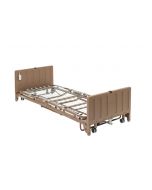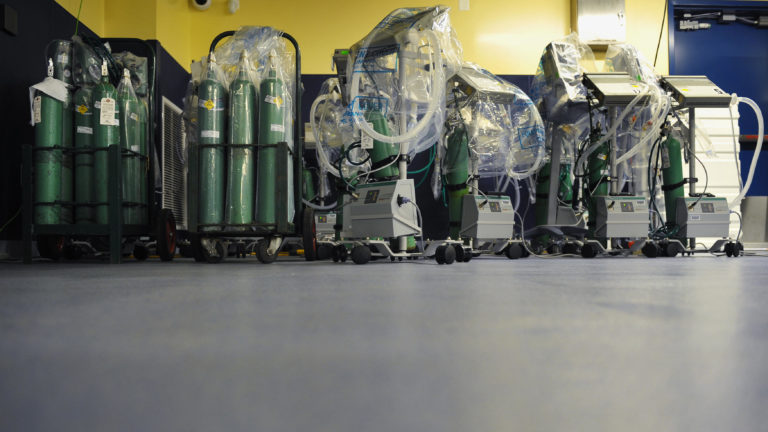
Demand for medical supplies such as ventilators and face masks skyrocketed as COVID-19 took hold. The situation led policymakers to examine how America can better manage medical supply chains.
Tori Smith, a trade economist at The Heritage Foundation, joins The Daily Signal Podcast to discuss her new report on solutions to shortages of medical supplies. Listen to the podcast below or read the lightly edited transcript.
Virginia Allen: I am joined by Tori Smith, a trade economist at The Heritage Foundation. Tori, thanks so much for being here.
Tori Smith: It’s so great to be with you, Virginia. It’s like a little bit of community during this time when we just don’t get to see people too much.
>>> When can America reopen? The National Coronavirus Recovery Commission, a project of The Heritage Foundation, is gathering America’s top thinkers together to figure that out. Learn more here.
Allen: I know. Any chance to connect is awesome. I am really excited to talk with you today because you have a new report out that discusses solutions to medical-supply shortages.
Obviously, right now that’s something that we’re all very interested in, [and] we want to know more about. Your report is [titled] “The U.S. Should Focus on Targeted and Temporary Tools to Ensure Access to Medical Supply Chains.”
All during the coronavirus, there have been fears about running out of medical supplies; specifically, that we would not have enough ventilators for sick patients and even that we wouldn’t have enough personal protective equipment, such as gloves and masks.
President Donald Trump has taken measures such as the Defense Production Act to allow for increased supplies. Could you just explain what the Defense Production Act is and how it’s making a difference during the coronavirus?
Smith: Yes, absolutely. The president has taken a lot of different actions, using the Defense Production Act, but essentially it’s a law that dates back quite a ways that gives the president the authority to influence domestic industry in the interest of national defense.
For example, the president did this in March and invoked this order in March. He actually empowered the secretary of Health and Human Services and the secretary of Homeland Security to incentivize and even provide funding to or encourage different companies to move their production over to the items that we were seeing either shortages or potential shortages for.
An example of that is compelling General Motors to produce ventilators, 3M to produce more masks, and also different actions to increase the availability of components for ventilators. It’s a really important mechanism, but it’s a mechanism that has to be used in a targeted way because we don’t want the government to be too involved in private business, right?
Allen: Absolutely. Yeah, everything in proportion and correct timing. One of the other things that the administration has done is that they’ve opened up access to the Strategic National Stockpile. Can you explain what this is, why we have it, [and] has it been used in the past?
Smith: Yeah. The Strategic National Stockpile was created in 1999. Really, it’s there to ensure that we as a country are ready in an event of any sort of bioterrorism or public health crisis, anything from hurricanes to flu outbreaks.
Now, what’s really important to know about the Strategic National Stockpile, though, is it’s not necessarily meant to be the place where everyone goes for everything that they need in an emergency. The government can only stockpile so much.
It’s important that the Strategic National Stockpile is used in conjunction with other methods to increase supply in a time of great crisis like we’re seeing with this pandemic.
Allen: Really, those two things in combination, the Defense Protection Act and the Strategic National Stockpile, that’s really a great combination in order to get done what needs to be done.
Smith: Absolutely. Again, like I said before, and even though the title of the paper says that this should be used in a targeted manner, in a temporary manner. These are mechanisms that we should only use when it’s absolutely necessary. Once the shortage is mitigated, these things should pull back, and we should be using them less and getting the government back out of the market and letting the market work for itself.
But it’s really difficult sometimes for different industries to scale up production really quickly because it costs money. If they don’t have the infrastructure in place, they don’t have the capacity in place to, say, make an extra 2 million face masks in a week, then it’s helpful for these sorts of mechanisms to come in and bridge that gap.
Allen: That supply-and-demand concern has been so prevalent during COVID-19. Where does much of America’s medical supplies and pharmaceutical drugs traditionally come from? I mean, are most of these things domestically made, or do we import a lot of this?
Smith: What’s really wonderful about the expansion of trade and globalization is that we’re able to source our products from all around the world. The medical equipment and pharmaceutical supply chains are no different. That is really a big benefit to us. …
We want to make sure that we have diverse supply chains, diverse suppliers, so we can get things from many different countries and many different companies, so that we can better mitigate any sort of risk associated with solely relying on one thing.
We get pharmaceuticals from China, from Canada, from the [European Union], from India. About 28% of our what we call active pharmaceutical ingredients are from right here in the United States. But again, it’s very, very diverse. There are facilities all around the world that are monitored by [the Food and Drug Administration] and regulated by the FDA to make sure that they’re safe for all of us to consume.
Allen: You wrote in your report that the White House is considering an executive order that would require all federal agencies to purchase only American-made pharmaceuticals and medical equipment.
Tori, I love buying products with that Made in America sticker on them, but what is really the situation that we’re looking at here, as far as when we have this increased demand for medical supplies, don’t we need to be purchasing medical equipment from other countries to meet the needs of patients and medical personnel?
Smith: Yeah, so I think there’s really two big questions here. The first one is more kind of philosophical. If we believe in a free country and individuals being able to make choices for themselves, then it’s wonderful that we live in a place where, if you want to buy things that say Made in the USA on them, that you have the freedom to do that.
Then, if I want to buy things that say Made in India or—I don’t necessarily care where they’re made—then I have the freedom to do that, too. With the growing nature of globalization and the growing nature of trade, it’s actually becoming more and more difficult for things to actually be labeled that they were made in one country, because we have diverse supply chains that there are components that come from all around the world to get you that final good.
Now in terms of policy change in the middle of a pandemic, in my opinion, anything right now that would decrease our ability to get what we need when we need it is not great policy. The reason for that is that when you are cutting off a supply or a supply source, you’re going to create a shortage, or you’re going to create too much demand and not enough supply. There will be an imbalance there.
We want to make sure that any policies that we’re putting forward, especially right now, are not affecting our supply. If anything, they’re only increasing our supply.
Allen: Sen. Tom Cotton [R-Ark.] and Rep. Mike Gallagher [R-Wis.] have introduced legislation that really aims to end U.S. dependence on China from pharmaceutical manufacturing. The plan would be implemented over the course of two years. What do you think about this? I mean, is this a problem that we get so many of our drugs from China?
Smith: Well, two things here as well. The first one is that I think that there are good intentions here. There are good intentions with any policy like this; that is, the idea that we want to make more things here in America. I completely understand that.
The problem is that this sort of proposal really puts government intervening more in our markets, and that’s not what we want. Really, it kind of makes us a little bit more like China’s because that what China does. They manage their markets, and we don’t want to do that. We want to promote free markets.
The second part is, I think there’s actually a lot of misinformation about exactly how much pharmaceutical goods we import from China. There’s been a ton of numbers going around and a lot of misinformation.
Some statistics that I’d love to share with you that actually aren’t in the report are, for example, only about 30% of our antibiotic imports come from China. That means that we have a really diverse sourcing for these types of goods. Even if there were issues with the supply in China, there is still 70% that comes from either the U.S. or elsewhere.
Now within that, there are some goods that have a higher percentage, say, for example, ibuprofen. There’s a significant amount, almost all of the ibuprofen that is consumed by Americans is sourced from China, but there are also many other countries who make ibuprofen.
If we needed to make the shift, we could do that.
Allen: If we did make that shift, and let’s say we kind of stop relying so much on China or other countries for these pharmaceutical drugs, how would that affect the price of average prescriptions that Americans rely on?
Smith: That’s a really good question. I think, first and foremost, if a shift like this is going to happen, it shouldn’t be coming from overarching government policies that tell private business how they have to set up their supply chains.
We want this to be market-driven. The market driving it will help to make sure that prices stay affordable.
But naturally speaking, if you’re going to be cutting off a supply for our particular type of drug, you’re going to have increased prices.
It’s especially common for this to happen in the generic-drug space. The reason for that is because generic drug producers have such low margins that if they have to make a sourcing change, it could either make it unprofitable to make that good anymore so they wouldn’t make it anymore or they would have to increase the price substantially in order to even be able to sell the drug and bring it to market.
Allen: Even going beyond price, some people are worried that, OK, if we have a shift in who’s manufacturing these drugs, will we all of a sudden lose access? What would you say to those concerns?
Smith: Yeah, I mean, I think the two additional concerns other than price are choice, right? We as consumers want to be able to have the choice for what we buy. It’s great that we can buy Tylenol and Advil and Aleve and we have so many different brands and ingredients to choose from, all to do the same thing if curing a headache, right?
We want to make sure that that choice remains possible. If we’re cutting off or the government is saying, “Well, you can no longer buy this product from a particular country,” you’re going to be decreasing that choice.
The second problem is that change takes time. It takes a long time. The reason for that is because there are regulatory approvals that go along with new production being created or production being moved from one place to another.
That’s important for us as Americans because we want to make sure that the drugs that we are consuming are safe. That’s why the FDA does these regulatory production checks, but it takes a long time, and it’s very capital intensive. It takes a lot of money for a pharmaceutical manufacturer to … build a new factory to make new drugs and to find new suppliers. It all just takes time and money, and that makes it so that we have less choice and potentially higher prices.
Allen: That makes sense. Thank you for explaining that. So, Tori, let’s talk about solutions to medical shortages. How should the government really be positioning itself and America to be better prepared for future national medical emergencies, whether that’s a pandemic or bioterrorism?
Smith: Yes, absolutely. In terms of the broader question of drug sourcing and quality control through the FDA, Congress has actually already been working on some of this to make sure that not only is the FDA doing production-quality checks and learning more information about where different components of drugs come from, but they’re trying to make sure that all of these things are happening in an efficient and productive way.
What we have been recommending and what we recommend in this paper is, first and foremost, that a crisis is not the time to make big policy change. We want to make sure that policy change is done through a deliberative process after the crisis has passed because this is obviously not the norm, but our markets need to be able to operate in the norm.
That’s why these emergency procedures like [the] Defense Production Act and [Strategic] National Stockpile are very useful for dealing with the right now, so then we can get back to normal.
Allen: Really, we’re kind of talking about two different situations. We have the COVID-19 crisis and, obviously, addressing the needs that are at hand. But then when it comes to thinking about policy changes, those need to be implemented with the long-term future in mind.
Smith: That’s absolutely correct. We want to make sure that, like I said, any of the policy changes are being made with all the facts at hand. One thing that the government did do in the CARES Act is that they required the National Academies of Sciences, Engineering and Medicine to examine in a manner that doesn’t compromise national security more information about our medical product supply chain.
This will be really helpful for us as researchers and for Americans to have more information should they think that that is an important information to have to understand where supply chains are coming from.
This will also be helpful in any sort of future problems with supply chains or shortages because the FDA will be able to look at these numbers and understand kind of how the landscape is shifting within the pharmaceutical space.
Allen: Tori, we really appreciate your time today. We will be sure to leave a link to your report in the show notes so our audience can read it. But thank you so much for your insight and just so clearly explaining how unique the situation is that we’re in and what the steps forward should be for our nation.
Smith: Yes, thank you so much for having me.






Comments
Leave A Reply
Your email address will not be published.